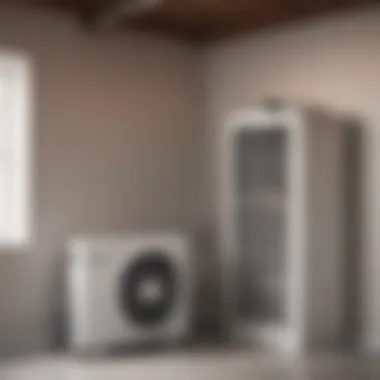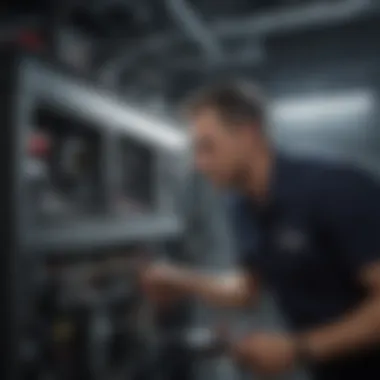Exploring Home Cooling Systems: Comprehensive Guide


Intro
In the realm of residential comfort, few elements play as significant a role as cooling systems. The pulse of daily life can be significantly altered by the temperature of our environment. Understanding the various cooling options available is essential for homeowners aiming to create an optimal living space. Not only is comfort paramount, but the growing emphasis on energy efficiency and ecological impacts renders this exploration even more relevant.
As summer months approach, our awareness of indoor climate control becomes vital. This article delves into crucial aspects of cooling systems designed for homes. The discussion will encompass the underlying technology of cooling, the evaluation of common systems such as central air conditioning, heat pumps, and ductless mini-split systems, as well as actionable tips for maintenance and selection.
By examining these facets, readers will be empowered to make informed decisions that enhance their living conditions while also being mindful of their economic and environmental footprints.
Foreword to Home Cooling Systems
In the context of modern living, home cooling systems have become not just an amenity but a necessity. The desire for comfort in residential environments has grown, particularly in regions where high temperatures pose a threat to well-being. Effective cooling systems contribute to a healthy indoor climate, protect from heat-related stress, and enhance the quality of life. Moreover, understanding the intricacies of these systems can lead to significantly reduced energy costs, promoting both economic and environmental sustainability.
The landscape of cooling technology is diverse. Homeowners can face challenges such as selecting the appropriate system for their specific needs and understanding the mechanics behind effective operation. This article aims to demystify this subject by providing a thorough examination of various types of cooling systems, their efficiencies, and their implications for the environment.
The Importance of Cooling Systems in Residential Spaces
Cooling systems play an essential role in regulating indoor temperatures. They are especially important during peak summer months when external conditions can become uncomfortable and even hazardous. The benefits of these systems extend beyond mere comfort. Properly functioning cooling systems can help protect delicate furnishings and electronic equipment from heat damage. Furthermore, they can improve air quality by filtering out particulates and humidity.
Home cooling systems can also be a deciding factor in property value. Homes equipped with efficient cooling technologies are often seen as more desirable. Therefore, investing in the right cooling solution can yield financial returns, making it a strategic choice for homeowners.
Objectives of This Article
This article seeks to achieve several objectives:
- Educate homeowners about different types of cooling systems available today, highlighting their specific functionalities and advantages.
- Explain the principles behind cooling technology, focusing on the science of heat transfer and the refrigeration cycle.
- Discuss energy efficiency ratings, such as SEER, to provide insights into making informed decisions regarding system purchases.
- Address environmental considerations related to cooling systems, particularly the impact of refrigerants.
- Offer practical tips for selecting, installing, and maintaining cooling systems to ensure efficiency and longevity.
- Provide guidance on tailoring choices to fit personal lifestyles and home specifications, ensuring that each homeowner can find the ideal solution.
Through a methodical exploration of these aspects, readers will gain a comprehensive understanding that empowers them to make informed decisions about home cooling systems. This knowledge is vital in today’s context, where comfort must coexist with responsibilities towards economic and ecological sustainability.
Understanding the Basics of Cooling Technology
Cooling technology is crucial in residential spaces. It affects comfort levels significantly. Understanding basic principles allows homeowners to select the right system. This section will cover important aspects that form the foundation of cooling technology. The goal is to provide insights that aid better decisions in system selection and overall home comfort.
Heat Transfer Principles
Heat transfer is a fundamental concept in cooling systems. It involves the movement of heat between spaces. Heat moves from warmer areas to cooler ones. This principle guides the operations of various cooling systems. There are three main types of heat transfer: conduction, convection, and radiation.
- Conduction occurs when heat moves through materials. For example, when warm air from outside comes in contact with a cool metal surface, heat will transfer from the warm air to the metal.
- Convection involves the movement of heat through fluids. In air conditioning systems, cool air is blown into a room. This air warms up as it interacts with warm surfaces, then rises and is replaced by cooler air.
- Radiation is the transfer of heat through electromagnetic waves. Sunlight, for instance, warms up surfaces directly without needing any medium.
Heat transfer principles are important because they guide how effectively a cooling system can lower indoor temperatures. A proper understanding leads to better system performance and energy efficiency. Additionally, each type of heat transfer has implications for insulation strategies in homes.
Refrigeration Cycle Explained
The refrigeration cycle is at the core of most cooling systems. This cycle describes the process of heat removal from an enclosed space, making it cooler. Understanding this cycle helps in grasping how different systems operate.
- Evaporation: The cycle begins when a refrigerant absorbs heat from the indoor air and evaporates, changing from liquid to gas. This process cools the air in the space.
- Compression: The gaseous refrigerant then moves to the compressor. Here, it is compressed into a high-pressure gas. This step raises its temperature.
- Condensation: The hot gas travels to the condenser coils outside. Here, it releases its heat to the outside air and condenses back into liquid.
- Expansion: Finally, the high-pressure liquid refrigerant passes through an expansion valve. This step reduces its pressure, allowing it to cool before re-entering the evaporator.
The refrigeration cycle is essential for maintaining comfortable indoor environments. Knowledge of this cycle helps homeowners understand factors affecting system efficiency, like proper sizing and maintenance.


"A well-understood cooling system enhances comfort and reduces energy bills."
Types of Cooling Systems
Understanding the different types of cooling systems is crucial for homeowners who seek to create a comfortable living environment. Each system comes with its unique features, advantages, and considerations. Choosing the right type can lead to significant savings on energy bills and improved indoor air quality. Additionally, knowledge about these systems can help in making informed decisions, whether for new installations or replacements.
Central Air Conditioning Systems
Central air conditioning systems offer widespread cooling for an entire home. They work by circulating cool air through a series of ducts. This type of system is favored for its effectiveness in larger homes, where a uniform temperature is desired. Central units are usually placed outside, connected to the home's ductwork.
Among their advantages is the ability to maintain a steady temperature throughout different rooms. Furthermore, these systems often come with advanced features like programmable thermostats, contributing to energy savings. However, installation can be costly, especially in homes without existing ductwork. Homeowners must consider both initial expenses and ongoing maintenance when opting for central air conditioning.
Ductless Mini-Split Systems
Ductless mini-split systems provide a flexible alternative to traditional central air conditioning. These systems consist of an outdoor compressor and one or more indoor units. They are ideal for homes lacking ducts or for extensions. Each indoor unit can be controlled independently, allowing for personalized comfort in various rooms.
Benefits include energy efficiency and lower installation costs when compared to ducted systems. However, they may require more frequent cleaning to maintain air quality, and aesthetic preferences vary, as indoor units are visible.
Window Air Conditioners
Window air conditioners are compact units designed to fit into a window frame. They serve as a practical solution for individual rooms or smaller spaces. Their installation is relatively easy compared to more extensive systems, making them popular among renters and homeowners alike.
Some advantages include affordability and portability. They can be moved from room to room as needed. Nevertheless, these units generally are less efficient than central or ductless systems in larger areas, and noise can be a concern in quieter neighborhoods.
Portable Air Conditioners
Portable air conditioners offer mobility and flexibility, allowing users to cool spaces without permanent installation. These units usually come with a venting kit that connects to a window or door to expel hot air. They are suitable for renters or those who do not want to commit to a more extensive system.
Although portable units are easy to set up and can be moved as desired, they do consume relatively more energy for the cooling effect they provide. Noise levels vary by model, and they typically require periodic drainage for optimal performance.
Evaporative Coolers
Evaporative coolers, also known as swamp coolers, are an environmentally friendly option that harnesses the power of water evaporation to cool the air. They work best in hot, dry climates where low humidity enhances their efficiency. These coolers draw in warm air, pass it over water-saturated pads, and release the cooler air into the space.
The major benefit of evaporative coolers is energy savings, as they use less electricity compared to traditional air conditioners. However, their effectiveness diminishes in areas with high humidity, as the moisture in the air inhibits the cooling process.
Energy Efficiency in Cooling Systems
Energy efficiency is a critical aspect of cooling systems for homes. It influences not only the operational costs of a system but also the overall comfort of living spaces. As energy prices rise, homeowners increasingly seek methods to lower energy consumption without sacrificing comfort. Understanding energy efficiency in cooling systems can lead to significant cost savings and environmental benefits.
One important factor in determining how efficient a cooling system is relates to its power consumption versus its cooling output. More efficient systems not only utilize less energy; they do so while maintaining or improving comfort levels in the home. This can enhance the property’s market value and appeal to prospective buyers who prioritize energy-efficient features.
Understanding SEER Ratings
Seasonal Energy Efficiency Ratio (SEER) is a key metric for evaluating the effectiveness of air conditioning systems. It measures the cooling output during a typical cooling season divided by the total electric energy input in watt-hours. A higher SEER rating indicates a more efficient system. Federal standards set a minimum SEER rating, and modern systems often exceed these buoyed by technological advancements.
While selecting a unit, homeowners should look for systems with SEER ratings well above the minimum. An investment in energy-efficient systems with high SEER ratings pays off over time, both in terms of reduced utility bills and corresponding lower environmental impact. It's also advisable to consider the regional climate since a higher SEER rating can be more beneficial in warmer areas where cooling is used more frequently.


Energy Star Certification
Energy Star is a widely recognized symbol for energy efficiency. Products under this label meet strict energy efficiency guidelines set by the U.S. Environmental Protection Agency. In terms of cooling systems, an Energy Star certified unit must offer substantial energy savings compared to standard models.
Choosing Energy Star certified systems often yields further financial incentives. Many utility companies provide rebates or incentives for installing such efficient units. This can help offset initial costs, making it an attractive option for budget-conscious homeowners. Additionally, these units typically come with better warranties, providing peace of mind about the investment.
Comparative Analysis of Energy Consumption
Comparing energy consumption among different cooling systems is essential in making informed decisions. Various systems have distinct performance profiles based on type, model, and additional features. For instance, central air conditioning typically consumes more power than ductless mini-split systems, which can target specific zones for cooling.
Understanding how environmental conditions affect energy consumption is also crucial. For instance, using a window air conditioner may suffice in cooler climates, but in hotter regions, a more robust central air system may be necessary. Homeowners should assess:
- Home Size: Larger spaces often require more energy.
- Usage Patterns: Frequency and duration of cooling can impact overall consumption.
- Age of System: Older models may be less efficient compared to new technologies.
Environmental Considerations
The topic of environmental considerations is crucial in the discourse around home cooling systems. The effects of cooling technology on the environment cannot be ignored. Various cooling systems, while essential for home comfort, have implications on energy consumption, greenhouse gas emissions, and resource sustainability. As homeowners become more aware of their ecological footprints, selecting a cooling system entails understanding these considerations. This section will explore specific elements regarding the environmental impacts of cooling systems and highlight the balance that must be struck between comfort and ecological responsibility.
Impact of Refrigerants on the Environment
Refrigerants play a key role in the operation of many cooling systems but can also pose significant environmental hazards. Traditional refrigerants, especially Hydrochlorofluorocarbons (HCFCs) and Chlorofluorocarbons (CFCs), have been linked to ozone depletion and global warming potential. The harmful effects of these substances underscore the urgency for their phased-out usage in favor of safer alternatives.
Current environmentally-friendly refrigerants, such as Hydrofluoroolefins (HFOs) and natural refrigerants like ammonia, show promise. They have a lower impact on both ozone depletion and climate change. Homeowners should prioritize systems that use these safer refrigerants. A conscious choice can minimize harm to the environment and promote a sustainable approach to residential cooling.
"Opting for cooling systems with environmentally safe refrigerants is a proactive step towards sustainable living."
Sustainable Cooling Solutions
Sustainability is an emerging consideration that shapes how cooling systems are designed and operated. Sustainable cooling solutions aim to deliver comfort while minimizing environmental impact. Some notable examples include:
- Geothermal Heat Pumps: They utilize the earth’s stable underground temperature for heating and cooling. This system is energy-efficient and reduces reliance on fossil fuels.
- Solar-Powered Air Conditioning: Utilizing solar panels can significantly reduce energy costs and reliance on non-renewable energy sources.
- Evaporative Coolers: These are energy-efficient and use water to cool air, offering a sustainable alternative in dry climates.
Using energy-efficient appliances and smart thermostats can also make an impact. These systems can optimize energy usage, reducing overall consumption. In addition, regular maintenance of cooling systems helps ensure they operate at peak efficiency, reducing environmental impact further.
Selecting the Right Cooling System for Your Home
Choosing an appropriate cooling system is critical for any homeowner. Not only does the right choice impact comfort, but it also affects energy consumption and costs. Understanding how various factors influence your cooling options ensures an informed decision. Whether for a large family or a small apartment, selecting the right system can significantly enhance your living experience.
Evaluating Home Size and Layout
The dimensions and design of your home play pivotal roles in selecting a cooling system. A larger home typically requires more powerful units or multiple systems to ensure even cooling. Central air conditioning systems are often a good fit for expansive spaces due to their capacity to circulate cool air throughout larger areas. Conversely, small homes or apartments might benefit more from ductless mini-split systems or portable air conditioners, which offer flexibility in installation.
It is also essential to consider the layout of the home. Homes with open floor designs permit better airflow, making it easier for cooling systems to function efficiently. On the other hand, houses with more segmented layouts may need multiple units in different areas to maintain a consistent temperature. Always measure square footage and account for ceiling height when evaluating potential cooling solutions.
Budget Considerations
Budget is a significant factor when choosing a cooling system. The initial cost can vary widely based on the type of system you select. Central air conditioning units generally have a higher upfront cost due to the installation of ductwork. In contrast, window units and portable air conditioners come with lower purchase prices, making them more affordable options for budget-conscious homeowners.


Beyond the initial costs, it is crucial to account for long-term expenses, such as energy consumption and maintenance. Energy-efficient models, while sometimes pricier upfront, can lead to substantial savings on utility bills. It's wise to analyze your potential cooling system's efficiency ratings. Additionally, remember to factor in repair costs when considering a unit. A more reliable system might be an initial investment but pays off in lower upkeep.
Lifestyle and Usage Patterns
Understanding your lifestyle will greatly influence your choice of cooling system. For instance, if you host frequent gatherings or have children who need space to play, a system capable of quickly cooling large areas may be necessary. Central air conditioning systems are often ideal in these scenarios, as they can maintain a comfortable temperature throughout larger spaces.
Alternatively, if you prefer a minimalist lifestyle or spend most of your time in specific rooms, ductless mini-split systems or window air conditioners might be better suited. These systems allow for targeted cooling, which can be more efficient and effective. Furthermore, consider daily habits, such as whether you are home during peak heat hours or prefer to cool your home just before returning. Aligning the cooling system with such patterns maximizes comfort and efficiency.
Installation and Maintenance
The installation and maintenance of cooling systems are critical aspects that directly influence their efficiency and longevity. A well-installed unit performs optimally, while regular maintenance ensures that it operates effectively throughout its lifespan. Homeowners often overlook these stages, focusing primarily on selecting a system without considering how essential proper installation and ongoing care are to a unit's functionality. The intricacies involved in both processes underscore their importance in minimizing costs and enhancing comfort at home.
Professional vs. DIY Installation
When it comes to installing a cooling system, homeowners must choose between professional installation and a do-it-yourself (DIY) approach. There are distinct advantages and challenges associated with both options.
- Professional Installation: Hiring experts can guarantee that the system is installed according to manufacturer specifications. Technicians are trained to handle potential issues that may arise during installation, minimizing risks such as improper sizing or ductwork complications.
- DIY Installation: On the other hand, opting for a DIY installation can save on labor costs. However, this approach requires a good understanding of electrical systems and plumbing. It may also void the warranty if not executed correctly.
Before deciding, assess your technical skills and the complexity of the installation. For systems requiring extensive modifications, like ductless mini-split systems, professional help is often advisable.
Regular Maintenance Practices
Maintaining a cooling system is essential to its performance and efficiency. Regular practices can prevent unexpected breakdowns and prolong the system’s life. Here are some key maintenance practices:
- Filter Replacement: Replace or clean filters every one to three months, depending on use. Clogged filters can obstruct airflow and reduce system efficiency.
- Cleaning Coils: Regularly clean evaporator and condenser coils. Dust accumulation can diminish heat exchange efficiency, leading to higher energy consumption.
- Check Refrigerant Levels: Ensure refrigerant levels are checked periodically. Low refrigerant can lead to overheating and system failure.
- Inspect Ductwork: Look for leaks or blockages in ductwork. Sealing these can significantly improve system efficiency.
Maintaining a schedule for these practices can simplify the process and ensure the system runs smoothly.
Signs Your System Needs Repair
Homeowners should be vigilant for indicators that their cooling systems might need attention. Recognizing these signs early can prevent more significant damage or more costly repairs in the future.
- Unusual Noises: Sounds like grinding or squealing may indicate mechanical failures.
- Poor Airflow: Reduced airflow could signal blocked ducts or failing components.
- Increased Energy Bills: A sudden spike in energy expenses can suggest inefficiencies in the cooling system.
- Inconsistent Temperatures: If certain rooms are hotter or cooler than others, this might indicate system malfunctions.
Regular inspections and prompt repairs can significantly affect comfort levels and cooling efficiency at home. Remember, addressing issues early can save time and money long-term.
"An ounce of prevention is worth a pound of cure." Keeping up with installation standards and maintenance practices is crucial for a cooling system’s well-being.
Being informed about installation and maintenance will empower homeowners to make decisions that best suit their needs. Understanding these elements will lead to better performance of cooling systems and ultimately improve the quality of life at home.
Culmination
The conclusion of this article highlights the significance of having a clear understanding of home cooling systems. It serves as a summary of elements discussed throughout the content. Knowing about various types of cooling systems and their functionalities aids homeowners in making choices that best fit their needs. Additionally, the focus on energy efficiency can lead to significant cost savings over time. Understanding environmental impacts also encourages more sustainable decisions.
Recap of Key Points
- Types of Cooling Systems: Each system, such as central air conditioning, ductless mini-splits, window units, portable air conditioners, and evaporative coolers, has distinct advantages and ideal applications based on home layout and climate.
- Energy Efficiency: SEER ratings and Energy Star certification are crucial metrics. Choosing efficient systems can minimize energy consumption and reduce utility bills.
- Environmental Considerations: The impact of refrigerants and the importance of adopting sustainable cooling solutions are vital for ecological responsibility.
- Selection Criteria: Evaluating home size, budget, and lifestyle needs ensures you choose the best cooling system for comfort and savings.
- Maintenance and Installation: Knowing whether to opt for a professional installation or DIY and understanding maintenance practices can prolong the lifespan of the cooling system.
Final Thoughts on Home Cooling
In every home, comfort is paramount, especially during warmer months. But, choosing the right cooling system is not just about comfort; it involves financial, environmental, and personal preferences. By synthesizing information from this article, homeowners can make well-informed decisions that not only enhance the living environment but also address economic factors and sustainability.
"Investing time in understanding your cooling options can lead to a more comfortable and environmentally friendly home."
Cooling systems are not merely appliances. They play a significant role in shaping the overall atmosphere of residential spaces, influencing both mood and energy levels. Thus, a tailored approach based on individual needs, preferences, and the landscape of the home is essential.



